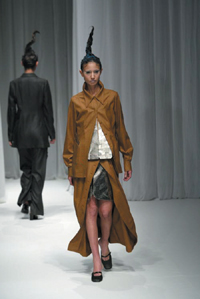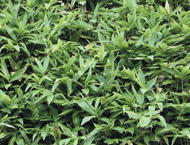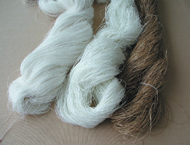Fighting Tech Stress with Style
Back to Contents of Issue: June 2003
|
|
|
|
by Mayumi Saito |
|
 Designer Michiyo Inaba presented an unusual line of clothes at the spring/summer 2003 Tokyo Collection show in December. Fourteen of her designs featured flashes of silver lining. The mysterious silver sheets were in suit pockets, peeking out from between skirt slits and beneath apron dresses. The material was a nanocrystal cobalt alloy, and while it added to the funky, high-tech feel of Inaba's collection, it also addressed a health concern: Inaba's detachable 1.2-mm-thick sheets block electromagnetic waves. Inaba designed the clothes to protect pregnant homemakers and wary businesswomen from the adverse health effects of electromagnetic stoves and cellular phones. The designer, herself allergic to synthetic clothes, has featured organic fabrics in past collections, but this time she was out to tackle the invisible threats of modern, high-tech devices. She is not alone in her concerns. "Consumers are "The development of comfortable and healthy apparel is expected to resurrect the fabric industry while meeting the high consumer demand for health benefits," says Kazuo Saito, a staff member specializing in fabric at Shizuoka Prefecture's Hamamatsu Industrial Technology Center. Inaba's efforts in the fashion world have found their way into everything from the beds people sleep in to the socks they wear. "Consumers are getting hysterical about health and looking for something in fashion to alleviate their fears," Inaba says. She feels dizzy while talking on a cellphone in an enclosed place, she adds. "Maybe it's because I am sensitive, but you can't deny the potential adverse health effects (of electromagnetic waves), even if there's no scientific proof." For her spring/summer collection, Inaba collaborated with Microwave Solution, a company that makes equipment to absorb electromagnetic waves from IT devices and the electronic toll collection system on Japan's highways. While absorbent aprons for office use are already on the market, the aprons made by Microwave Solutions and Inaba are for people using electronic cooking stoves at home. The company expects demand to increase as housing complexes with electric stoves proliferate. Conventional electric stoves are said to emit nearly 40 milligauss of electromagnetic waves. Wearing the "armor" apron can reduce exposure to one-tenth of that amount, according to Microwave Solution president Satoshi Ogino. The aprons sell at Inaba's store and through other channels for around JPY30,000, and the company was aiming for sales of JPY80 million in the fiscal year that ended in March.
Industry in crisis
The industry's trade deficit has grown since 1986, according to Saito. Japan's fabric industry currently generates annual revenue of JPY7.6 trillion. That's 50 percent down from a decade ago. Releasing innovative and marketable materials has become the challenge for manufacturers. They are now honing technologies and developing synthetic fabric with the help of Mother Nature, and these new fabrics are leading to a slew of "healthy" products. Shirtmaker Flex Japan started collaborating with fiber brand Toyobo and Shinshu University to develop kenaf shirts in 1996. Kenaf, a cannabis plant, is easy to grow and environmentally friendly because it absorbs carbon dioxide and helps prevent global warming. Its porous fiber also breathes well, but it had long been thought to be too thick for clothing. Combining vertically split kenaf fiber with cotton and polyester, Flex Japan produced breathable and fast-drying kenaf shirts after four years of the joint project. The company sold 120,000 summer shirts in 2002. Responding to requests for all-season shirts, the company wove in polynosic yarn to make the surface smoother. It started to market the new dress shirts in March. The four-season shirts are soft and smooth, keeping the inner temperature steady. They sell for anywhere from JPY3,900 to JPY5,900, and the company aims to move 150,000 shirts this fiscal year. The men's shirt market is currently overflowing with JPY2,900 products. "Consumers go cheap when there are no distinctive items," Flex Japan's textile department assistant leader Yuji Kitazawa says. "An attractive product will sell even if the price is high." The market average for men's shirts in Japan is 50 million shirts per year. Flex Japan, which sells 10 million of those shirts, produces 85 percent of its shirts at affiliated factories overseas -- five in China and one in Indonesia. Kenaf shirts, the company's first original product, constitute just 1 percent of the entire market, yet Kitazawa considers it a good start.
Bamboo wear for the links
Itoi Textile has developed sasawashi yarn with Mitsuo Kimura, a doctor of engineering, since 1996. The company uses the yarn to make deodorized, anti-bacterial socks, towels and bedclothes. The porous fiber also absorbs excess water and blocks ultraviolet rays. Sun Trade plans to introduce its golf wear to larger golf equipment makers this fiscal year. Sasawashi provides additional herbal benefits, such as improving circulation and healing inflammation or allergies. At a fashion industry conference last Decem-ber, Itoi Textile's president, Toru Itoi, demonstrated how a sasawashi towel could cure gum diseases when used to massage one's gums. Consulting firm Osaka Textile Resource Center has put together a "Sasawashi Study Group" made up of members from the Kansai area's 200 fabric manufacturers and trading companies. The group will exchange ideas for developing new products based on Itoi Textile's technology. Bedding maker Showa Nishikawa is another company hoping to woo customers with promises of a healthier life -- and deeper sleep. It has been selling its "coral comforters" since early this year. The coral from Okinawa reportedly contains more than 40 kinds of minerals and emits extensive negative ions (for more on negative ions, see our article Ion Power, page 9, December 2002). Coral is often used for the foundation and walls of old houses or pavement in Okinawa, home to the world's longest-living people. Inspired by doctor Ju Kihwan's study of coral in 2000, Showa Nishikawa mixed particles of weathered coral with ceramics to coat down comforters or futons. The negative ions emitted by the coral are supposed to relax the body and induce deeper sleep, while suppressing static. Although Japan already has tourmaline-lined futons that produce a similar effect, the coral comforters release as much as 30 times more negative ions, according to the Nihon Kaiji Kentei Kyokai Physical & Chemical Analysis Center. "Although sleep makes up one-third of our life, not many people have paid enough attention to their bedding environment," says Showa Nishikawa's sales planning chief Kenichi Yamada.
Is the abundant production of health-conscious fabrics just another fad? Designer Inaba, for one, is encouraged by what she sees. "If we can integrate our ideas and technology well, the local fabric industry will have enormous potential." @ Mayumi Saito, a Tokyo-based freelance writer, regularly writes about technology and business trends for J@pan Inc. |
|
Note: The function "email this page" is currently not supported for this page.



 The coral comforters are hitting shelves with the same price tags as regular futon sets. "Consumers take additional benefits for granted these days," Yamada says. The company is aiming for comforter sales of JPY1 billion this year.
The coral comforters are hitting shelves with the same price tags as regular futon sets. "Consumers take additional benefits for granted these days," Yamada says. The company is aiming for comforter sales of JPY1 billion this year.



